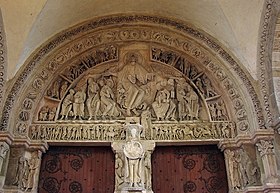Atympanum (pl.: tympana; from Greek and Latin words meaning "drum") is the semi-circular or triangular decorative wall surface over an entrance, door or window, which is bounded by a lintel and an arch.[1] It often contains pedimental sculpture or other imagery or ornaments.[2] Many architectural styles include this element.[3]

Alternatively, the tympanum may hold an inscription, or in modern times, a clock face.
Inancient Greek, Roman and Church architecture, tympana of religious buildings often contain pedimental sculptureormosaics with religious imagery.[4] A tympanum over a doorway is very often the most important, or only, location for monumental sculpture on the outside of a building. In classical architecture and in classicizing styles from the Renaissance onwards, prominent examples are usually triangular; in Romanesque architecture, tympana more often have a semi-circular shape or that of a thinner slice from the top of a circle, and in Gothic architecture they have a more vertical shape, coming to a point at the top. These shapes naturally influence the typical compositions of any sculpture within the tympanum.
The upper portion of a gable when enclosed with a horizontal belt course, is also termed a tympanum.[5]
Bands of molding surrounding the tympanum are called the archivolt.[6]
In medieval French architecture, the tympanum is often supported by a decorated pillar called a trumeau.